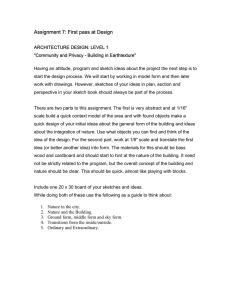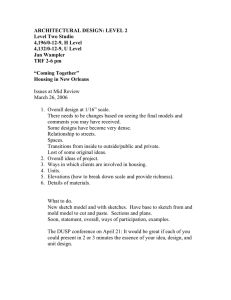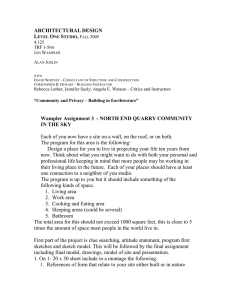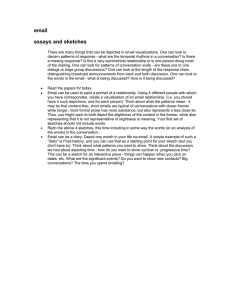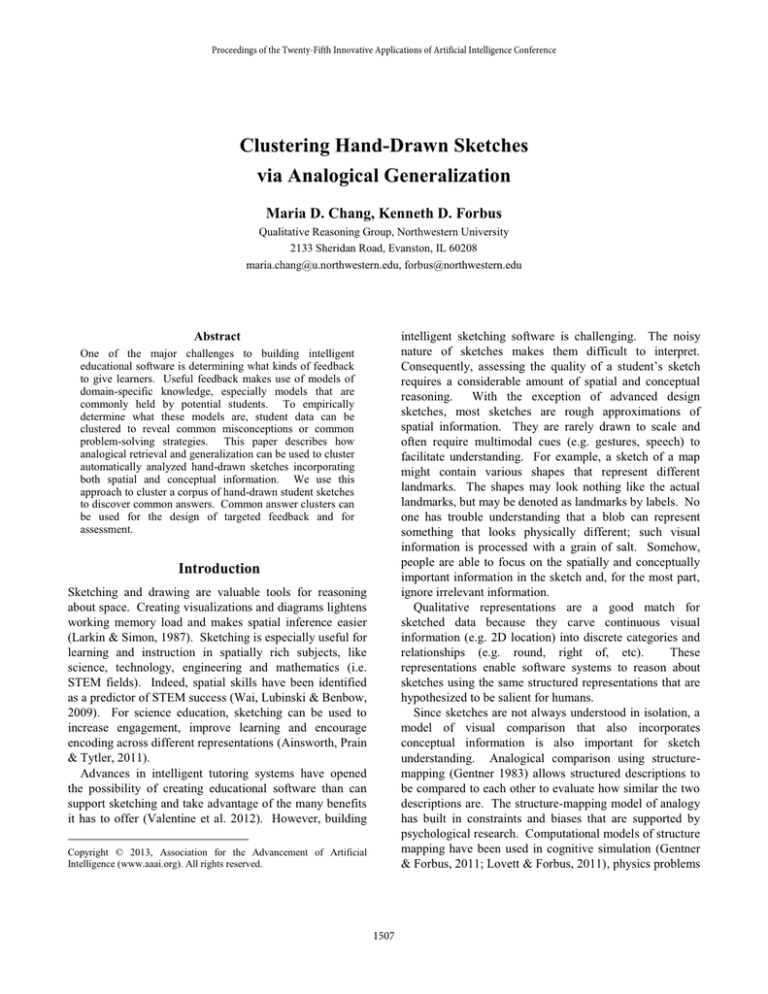
Proceedings of the Twenty-Fifth Innovative Applications of Artificial Intelligence Conference
Clustering Hand-Drawn Sketches
via Analogical Generalization
Maria D. Chang, Kenneth D. Forbus
Qualitative Reasoning Group, Northwestern University
2133 Sheridan Road, Evanston, IL 60208
maria.chang@u.northwestern.edu, forbus@northwestern.edu
intelligent sketching software is challenging. The noisy
nature of sketches makes them difficult to interpret.
Consequently, assessing the quality of a student’s sketch
requires a considerable amount of spatial and conceptual
reasoning.
With the exception of advanced design
sketches, most sketches are rough approximations of
spatial information. They are rarely drawn to scale and
often require multimodal cues (e.g. gestures, speech) to
facilitate understanding. For example, a sketch of a map
might contain various shapes that represent different
landmarks. The shapes may look nothing like the actual
landmarks, but may be denoted as landmarks by labels. No
one has trouble understanding that a blob can represent
something that looks physically different; such visual
information is processed with a grain of salt. Somehow,
people are able to focus on the spatially and conceptually
important information in the sketch and, for the most part,
ignore irrelevant information.
Qualitative representations are a good match for
sketched data because they carve continuous visual
information (e.g. 2D location) into discrete categories and
relationships (e.g. round, right of, etc).
These
representations enable software systems to reason about
sketches using the same structured representations that are
hypothesized to be salient for humans.
Since sketches are not always understood in isolation, a
model of visual comparison that also incorporates
conceptual information is also important for sketch
understanding. Analogical comparison using structuremapping (Gentner 1983) allows structured descriptions to
be compared to each other to evaluate how similar the two
descriptions are. The structure-mapping model of analogy
has built in constraints and biases that are supported by
psychological research. Computational models of structure
mapping have been used in cognitive simulation (Gentner
& Forbus, 2011; Lovett & Forbus, 2011), physics problems
Abstract
One of the major challenges to building intelligent
educational software is determining what kinds of feedback
to give learners. Useful feedback makes use of models of
domain-specific knowledge, especially models that are
commonly held by potential students. To empirically
determine what these models are, student data can be
clustered to reveal common misconceptions or common
problem-solving strategies. This paper describes how
analogical retrieval and generalization can be used to cluster
automatically analyzed hand-drawn sketches incorporating
both spatial and conceptual information. We use this
approach to cluster a corpus of hand-drawn student sketches
to discover common answers. Common answer clusters can
be used for the design of targeted feedback and for
assessment.
Introduction
Sketching and drawing are valuable tools for reasoning
about space. Creating visualizations and diagrams lightens
working memory load and makes spatial inference easier
(Larkin & Simon, 1987). Sketching is especially useful for
learning and instruction in spatially rich subjects, like
science, technology, engineering and mathematics (i.e.
STEM fields). Indeed, spatial skills have been identified
as a predictor of STEM success (Wai, Lubinski & Benbow,
2009). For science education, sketching can be used to
increase engagement, improve learning and encourage
encoding across different representations (Ainsworth, Prain
& Tytler, 2011).
Advances in intelligent tutoring systems have opened
the possibility of creating educational software than can
support sketching and take advantage of the many benefits
it has to offer (Valentine et al. 2012). However, building
Copyright © 2013, Association for the Advancement of Artificial
Intelligence (www.aaai.org). All rights reserved.
1507
solving (Klenk & Forbus, 2009; Lockwood & Forbus
2009), and question answering (Murdock, 2011).
Structure-mapping enabled these systems to make more
human-like comparisons. In educational software, such as
Sketch Worksheets (Yin et al. 2010) structure-mapping
generates comparisons that can be used to assess a
student’s sketch by comparing it to a pre-defined solution.
A major challenge in any intelligent tutoring system is
determining how to coach students. When designing
feedback, instructors must hypothesize what will be hard
for students. Such hypotheses are not always data driven
and can be inaccurate (Nathan, Koedinger & Alibali,
2001). Consequently, most successful intelligent tutoring
systems incorporate detailed cognitive models of the task
being taught. Building cognitive models requires research
on novice misconceptions and strategies (Anderson et al.
1995). Some systems also model the strategies of human
tutors, such as intervention techniques and tutoring
dialogue (VanLehn et al. 2007). However, creating
cognitive models for both correct knowledge and common
misconceptions for an entire domain is difficult. On the
other hand, specific exercises can have easily defined
misconceptions that can be identified without a full
analysis of the domain. By analyzing the work of multiple
students on an example, common models (some of which
may be misconceptions) can be mined from the data.
Although there has been work devoted to assessing student
knowledge through sketches (Jee et al. 2009; Kindfield,
1992) and mining information about students from learning
data (e.g. from hand-coded sketches, Worsley &
Bliknstein, 2011) we are unaware of any efforts to combine
automatic sketch understanding and educational data
mining. This paper describes an approach for using
analogical reasoning over hand-drawn sketches to detect
common student answers.
Our hypothesis is that analogical generalization can be
used to generate meaningful clusters of hand-drawn
sketches. We compare analogical generalization to a kmeans clustering algorithm and evaluate its performance
on a set of labeled (i.e. clustered by hand) student sketches.
The resulting clusters from the experiments can be
inspected to identify the key characteristics of each cluster.
These characteristics can be used to identify student
misconceptions and to design targeted feedback for
students.
software system used to collect and encode hand-drawn
sketches.
Structure Mapping
The structure-mapping engine (SME) (Faulkenhainer,
Forbus & Gentner, 1989) is a computational model of
analogy that compares two structured descriptions, a base
and a target, and computes one or more analogical
mappings between them. Each mapping contains a set of
correspondences, which indicate which items in the base
correspond to which items in the target, a structural
evaluation score, which is a measure of match quality, and
a set of candidate inferences, which are statements that are
true in the base and hypothesized to be true in the target.
Several constraints are imposed on the mapping process to
prevent all potential mappings from being computed and to
account
for
certain
psychological
phenomena.
Importantly, SME has a bias for mappings with greater
systematicity, which means that it prefers mappings with
systems of shared relations.
To create sketch clusters, we use SAGE (sequential
analogical generalization engine), an extension of SEQL
(Kuenhe et al 2000) which computes probabilities for
expressions during generalization and retrieves structured
descriptions using analogical retrieval. Generalizations are
created by incrementally introducing exemplars into a
generalization context.
Each generalization context
consists of a case library that includes both exemplars and
generalizations. For each new exemplar, the most similar
exemplar or generalization in the generalization context is
retrieved by an analogical reminding via MAC/FAC
(Forbus, Gentner & Law, 1995). MAC/FAC computes
content vectors that measure the relative frequency of
occurrence of relations and attributes in structured
representations. It finds the maximum dot product of the
vector for the probe with the vectors of everything in the
generalization context. This step may retrieve up to three
items and is analogous to a bag of words approach to
similarity, albeit with predicates. These items are then
compared to the probe using SME and the item with the
highest structural evaluation score is returned.
The reminding returned by MAC/FAC (either an
exemplar or an existing generalization) is merged with the
new exemplar if their similarity is above a pre-defined
assimilation threshold.
If the best match is a
generalization, the new exemplar is added to it. If the best
match is another exemplar, then the two are combined into
a new generalization. If there is no best match above the
assimilation threshold, then the new exemplar is added
directly to the case library for that generalization context.
It will remain an exemplar in the generalization context
until it is joined with a new exemplar or until there are no
more exemplars to add.
Background
Structure-mapping is the comparison mechanism of our
clustering approach.
Here we summarize the
computational models for analogical matching, retrieval
and generalization that we use. We then describe Sketch
Worksheets, which is our sketch-based educational
1508
The resulting generalizations contain generalized facts
and entities. Each fact in a generalization is assigned a
probability, which is based on its frequency of occurrence
in the exemplars included in the generalization. For
example, a fact that is true in only half of the exemplars
would be assigned a probability of 0.5. Thus entities
become more abstract, in that facts about them “fade” as
their probability becomes lower.
is contained by the orbit rings of other planets. In other
words, its location is constrained by its location relative to
other drawn entities. Alternatively, consider a worksheet
that asks a student to identify the temporal lobe on a
diagram of the human brain. The absolute location of the
drawing denoting the temporal lobe would be important.
For an element whose location is constrained relative to an
absolute frame of reference (e.g. a background image),
quantitative ink constraints are necessary.
Sketch Worksheets have been used in experiments on
spatial reasoning as well as classroom activities in
geoscience and elementary school biology. The sketches
used in the experiments described in this paper were
collected using sketch worksheets.
Clustering via Analogical Generalization
Clustering is achieved by performing analogical
generalization over student sketches. The clustering
algorithm adds the sketches in random order, using the
SAGE algorithm described above. A single generalization
context is used, i.e. it operates unsupervised, because the
goal is to see what clusters emerge.
Encoding
Figure 1: Four example student sketches. The bottom
two are grouped together and considered nearly correct.
The top two occupy their own single-member clusters.
A major challenge to clustering sketches is choosing how
to encode the information depicted in each sketch. Each
sketch contains a wealth of spatial information, not all of it
relevant for any particular situation.1 In order to highlight
visually and conceptually salient attributes and
relationships, we harness information explicitly entered by
the student and the worksheet author. More specifically,
we filter the underlying representations in each sketch
based on the following principles: conceptual information
is critical, quantitative ink constraints must constrain
analogical mappings, and worksheet authoring should
guide spatial and conceptual elaboration.
Sketch Worksheets
Sketch Worksheets are built within CogSketch (Forbus et
al 2011), our open-domain sketch understanding system.
Each sketch worksheet includes a problem statement, a
pre-defined solution sketch and a workspace where the
student sketches his or her candidate answer. As part of
the authoring process, the worksheet author describes the
problem and sketches an ideal solution. CogSketch
analyzes the solution sketch by computing qualitative
spatial and conceptual relations between items in the
sketch. The worksheet author can then peruse these
representations and identify which facts are important for
capturing the correctness of the sketch. The author can
also identify which drawn elements have quantitative
location criteria by defining quantitative ink constraints,
which define a tolerance region for a particular drawn
element. If the student’s drawn element falls outside of the
tolerance region, it is considered incorrect. If it falls within
the tolerance region, it is considered correct.
The difference between these two criteria types can be
illustrated by two different worksheet exercises. Consider
a worksheet that asks a student to draw the solar system.
The exact location of the sun does not matter, as long as it
Conceptual Information
Every sketch worksheet comes equipped with a subset of
concepts from an OpenCyc-derived knowledge base. This
subset contains the concepts that may be used in the
worksheet and are selected by the worksheet author to limit
the conceptual scope of the exercise. These concepts are
applied by students to elements of their drawing via
CogSketch’s conceptual labeling interface. This is useful
for education because the mapping between shapes and
entities is often one to many. While visual relationships
are computed automatically by CogSketch, conceptual
relationships are entered by sketching arrows or
1
For example, a student might draw a planet above the sun versus below
the sun, a visually salient difference that doesn’t matter in most orbital
diagrams.
1509
annotations and labeling them appropriately, via the same
interface. Thus the conceptual labels constitute the
student’s expression of their model of what is depicted.
Consequently, conceptual information is always encoded
for generalization.
gold standard was created by hand-clustering the sketches
for each exercise separately.
We then ran our
generalization algorithm on the unlabeled data for each
exercise, to evaluate how well the clusters it produced
match the gold standard. Because clusters may differ
depending on the order in which sketches are selected, we
repeated the clustering over 10 iterations. We collected
three measures from the resulting clusters: purity, precision
and recall.
Quantitative Ink Constraints Limit Matches
Another type of information that is entered explicitly by
the worksheet author are quantitative ink constraints.
Recall that quantitative ink constraints define a tolerance
region relative to an absolute frame of reference (e.g. a
background image). Quantitative ink constraints are
defined for entities whose absolute position matters.
When encoding information about entities for which
there are quantitative ink constraints, the encoding
algorithm computes their position with respect to the
tolerance regions, to determine if the entity’s location
meets the constraint or not. If it does not, we further
encode how the constraint was violated (e.g. too wide, too
narrow, etc.) and include that information in the encoding.
Furthermore, each entity that is evaluated with respect to
a quantitative ink constraint is associated with that
constraint as a location-specific landmark.
This
association limits the possible analogical mappings by
ensuring that entities associated with one landmark cannot
map to entities that are associated with a different
landmark. This also ensures that entities cannot be
generalized across different location-specific landmarks.
This approach for using quantitative constraints to limit the
analogical mappings has been shown to lead to sketch
comparisons that provide more accurate feedback to
students (Chang & Forbus, 2012).
K-Means Clustering
To explore the impact of relational structure on
generalization behavior, we also compared our approach to
a non-structural way of ascertaining similarity.
Specifically, we used the MAC/FAC content vectors
(described above) as a cruder, non-relational form of
similarity. While content vectors are still sensitive to the
presence of relationships, since those predicates are
included in them, it only contains relative frequency
information. In other words, “man bites dog” is the same
as “dog bites man.” We used k-means clustering on the
same data, where each mean was the content vector of a
sketch and the distance measure between means was the
inverse dot product of the content vectors being compared.
The more overlap between the content vectors, the greater
the similarity and the smaller the distance. For each kmeans clustering process we supplied k by counting the
number of labeled clusters. In this sense, the k-means
clustering approach had a slight advantage over analogical
generalization. The k-means clustering algorithm was also
repeated 10 times, since the initial k means can impact the
makeup of clusters.
Spatial and Conceptual Elaboration
Worksheet authors can also specify a subset of the visual
relationships computed by CogSketch as important. For
example, the core of the Earth must be inside its mantle.
Some conceptual information can also be marked as
important, e.g. a sketch of a fault must include marker
beds. All facts marked as important by the worksheet
author, whether spatial or conceptual, are always included
in the encoding for generalization.
Results
Table 1 shows the average purity, precision and recall for
each approach across the 3 worksheet groups, averaged
over 10 iterations of each approach. Analogical
generalization outperformed k-means without analogy for
clustering in all measures. Since purity is often high when
there are many clusters, it is important to consider the
precision and recall measures as well.
We used independent samples t-tests to test for
significant differences between purity, precision and recall
for each sketch group separately (for a total of 9
comparisons). Each measure was significantly higher for
analogical generalization than for k-means clustering (p <
0.005, Bonferroni corrected for 9 comparisons).
Evaluation
To evaluate our clustering algorithm we used a set of fault
identification worksheets (e.g. Figure 1) submitted by
students taking an undergraduate geoscience course at
Northwestern University. There were 28 sketches in total,
spanning three different fault identification exercises. A
1510
Figure 2 shows two sketches that were frequently
generalized together. This cluster indicates a common
sketching behavior exhibited by students. The high
probability facts in the generalization indicate the defining
criteria for the cluster. Most of the high probability facts in
this generalization are concept membership attributes.
Other facts refer to the direction of the sketched diagonal
arrows in the sketch. These facts were already considered
in the feedback design of this worksheet. However, the
three high probability facts shown in Figure 2 indicate the
potential for more targeted feedback. These facts indicate
that three of the four marker beds failed quantitative ink
constraints in specific ways. The bold horizontal arrows
imposed on the figure point to two marker beds that map to
each other in an analogical mapping. Both of these marker
beds fall short of the left bounds of their quantitative ink
constraints (see first fact in Figure 2). Similarly, two other
marker beds (unmarked) fall short of the right bounds of
the quantitative ink constraints. Without knowing that
multiple students would exhibit this common behavior, a
worksheet author would have no reason to include targeted
feedback about it. However, given that multiple students
commit this error, targeted feedback about the horizontal
extent of marker beds would have been helpful, e.g.
“Marker bed regions are not just near the fault; they can
extend to the edges of the image.”
Sketch Group #1
Number of Clusters
Purity**
Precision**
Recall*
Sketch Group #2
Number of Clusters
Purity**
Precision**
Recall**
Sketch Group #3
Number of Clusters
Purity**
Precision**
Recall*
SAGE
k-means
6.7
0.90
0.86
0.85
6
0.72
0.56
0.56
5.5
0.94
0.98
0.82
4
0.74
0.61
0.59
6.1
0.96
0.99
0.80
4
0.83
0.67
0.68
(lessThanQuantInkLeftBound
(GenEntFn 5 1 Faults-1) Object-438)
(lessThanQuantInkRightBound
(GenEntFn 3 1 Faults-1) Object-440)
(lessThanQuantInkRightBound
(GenEntFn 4 1 Faults-1) Object-436)
Figure 2: Two sketches that are frequently clustered
together and three high-probability facts from their
generalization. The horizontal block arrows point to
the drawn entity that is referenced in the first fact.
That entity falls short of the left bound of its
quantitative ink constraint.
Related Work
Many researchers have explored misconceptions in
domains like algebra, geometry (Anderson et al. 1995) and
physics (VanLehn et al. 2007). Each of these research
programs answers important questions about the structure
of knowledge during leaning. These answers have shaped
the coaching strategies of various tutoring systems.
Many sketch understanding systems exist but most stick
to a single domain because they use sketch recognition
(Lee et al. 2007; de Silva et al. 2007; Valentine et al.
2012). No other sketch understanding systems use
structure-mapping as a model for comparison. Despite
this, it may still be possible to apply similar clustering
techniques to those systems.
Discussion and Future Work
This paper describes a method for clustering sketches to
detect common answer patterns. We used models of
human analogical processing to cluster hand-drawn
sketches completed by undergraduate geoscience students.
The analogical clustering approach significantly
outperformed a k-means clustering algorithm.
This technique can be used to mine common answer
patterns from sketches so that they can be used for
assessment or for designing targeted feedback. Instructors
may use this technique to discover the distribution of
answer patterns in their classrooms, some of which may be
prevalent misconceptions. This approach enables common
answer detection in a data-driven (but tightly scoped)
Table 1: Clustering measures for analogical generalization
(SAGE) and k-means clustering (without analogy). All
measures are averaged over 10 random restart iterations of
the clustering procedure. Asterisks indicate the probability
associated with independent samples t-tests between SAGE
and k-means measures: ** p < 0.001, * p < 0.005.
1511
research and for education. Topics in Cognitive Science, 3, 648666.
Gentner, D. & Forbus, K., 2011. Computational models of
analogy. Wiley Interdisciplinary Reviews: Cognitive Science.
2(3), 266-276.
Gentner, D., 1983. Structure-mapping: A theoretical framework
for analogy. Cognitive Science, 7(2), 155-170.
Jee, B., Gentner, D., Forbus, K. D., Sageman, B. and Uttal, D. H.,
2009. Drawing on experience: Use of sketching to evaluate
knowledge of spatial scientific concepts. Proceedings of the 31st
Annual Conference of the Cognitive Science Society.
Kindfield, A. C. H., 1992. Expert diagrammatic reasoning in
biology. In Proceedings of the AAAI Spring Symposium. Palo
Alto, CA.
Klenk, M. and Forbus, K., 2009. Analogical model formulation
for transfer learning in AP Physics.
Artificial Intelligence
173(18), 1615-1638.
Kuehne, S., Forbus, K., Gentner, D. and Quinn, B., 2000. SEQL:
Category learning as progressive abstraction using structure
mapping. Proceedings of CogSci 2000.
Larkin, J. H. and Simon, H. A., 1987. Why a diagram is
(sometimes) worth 10000 words. Cognitive Science, 11(1), 65-99.
Lee, W., De Silva, R., Peterson, E. J., Calfee, R. C. and
Stahovich, T. F., 2007. Newton’s pen – a pen-based tutoring
system for statics. In Proceedings of the Eurographics Workshop
on Sketch-Based Interfaces and Modeling. Riverside, CA.
Lockwood, K. & Forbus, K., 2009. Multimodal knowledge
capture from text and diagrams. Proceedings of KCAP-2009.
Lovett, A., Kandaswamy, S., McLure, M., & Forbus, K., 2012.
Evaluating qualitative models of shape representation.
Proceedings of the 26th International Workshop on Qualitative
Reasoning. Los Angeles, CA.
Murdock, J., 2011. Structure mapping for jeopardy! clues. CaseBased Reasoning Research and Development, 6-10.
Nathan, M., Koedinger, K. R., & Alibali, M., 2001. Expert blind
spot: When content knowledge eclipses pedagogical content
knowledge. In Proceedings of the Third International Conference
on Cognitive Science, 644-648.
Valentine, S., Vides, F., Lucchese, G., Turner, D., Rim, H., Li,
W., Linsey, J., Hammond, T., 2012. Mechanix: A Sketch-Based
Tutoring System for Statics Courses. Innovative Applications of
Artificial Intelligence (IAAI). Toronto, Canada.
VanLehn, K., Graesser, A. C., Jackson, G. T., Jordan, P., Olney,
A., & Rosé, C. P., 2007. When are tutorial dialogues more
effective than reading?. Cognitive Science, 31(1), 3-62.
Yin, P., Forbus, K. D., Usher, J., Sageman, B. and Jee, B., 2010.
Sketch worksheets: A sketch-based educational software system.
Innovative Applications of Artificial Intelligence (IAAI).
Portland, OR.
Wai, J., Lubinski, D., & Benbow, C. P., 2009. Spatial ability for
STEM domains: Aligning over 50 years of cumulative
psychological knowledge solidifies its importance. Journal of
Educational Psychology, 101(4), 817.
Worsley, M. and Blikstein P., 2011. What’s an Expert? Using
learning analytics to identify emergent markers of expertise
through automated speech, sentiment and sketch analysis. In
Proceedings for the 4th Annual Conference on Educational Data
Mining.
manner, without requiring a cognitive analysis of the entire
domain or even the entire task.
One of the limitations to this approach is the
understandability of the facts used to describe
generalizations. As discussed above, high-probability facts
can be used to understand the defining criteria of a cluster.
For an instructor to easily interpret these facts would
require familiarity with the knowledge representations used
there. However, it can be argued that the instructor may
not need those explicit facts. Instead, they can simply view
a prototypical member of the cluster and decide on the
defining criteria for themselves. With this technique,
rather than looking at all the sketches submitted by
students, an instructor can inspect only as many sketches as
there are clusters.
In the future we plan to continue refining encoding
procedures of sketches. The procedures used in this
experiment are domain general, but there are likely cases
where tighter filters on conceptual information will be
needed. We also have not yet integrated shape and edge
level representations into this encoding procedure (Lovett
et al. 2012), as these are only now starting to be integrated
into our sketch worksheets. We also plan to add clustering
to the grading utilities built into sketch worksheets.
Acknowledgements
Thanks to Brad Sageman and Andrew Jacobson and their
students, for providing us with expertise, advice, and data.
This work was supported by the Spatial Intelligence and
Learning Center (SILC), an NSF Science of Learning
Center (Award Number SBE-1041707).
References
Ainsworth, S., Prain, V. and Tytler, R., 2011. Science education.
Drawing to learn in science. Science, 333(6046), 1096-1097.
Anderson, J. R., Corbett, A. T., Koedinger, K. R., & Pelletier, R.,
1995. Cognitive tutors: Lessons learned. The Journal of the
Learning Sciences, 4(2), 167-207.
Chang, M.D., Forbus, K.D., 2012. Using quantitative information
to improve analogical matching between sketches. Innovative
Applications of Artificial Intelligence (IAAI). Toronto, Canada.
de Silva, R., Bischel, T. D., Lee, W., Peterson, E. J., Calfee, R. C.
and Stahovich, T., 2007. Kirchhoff's pen: A pen-based circuit
analysis tutor. In Proceedings of the 4th Eurographics workshop
on Sketch-based interfaces and modeling.
Falkenhainer, B., Forbus, K., & Gentner, D., 1989. The structuremapping engine: Algorithm and examples. Artificial Intelligence,
41(1), 1-63.
Forbus, K., Gentner, D., and Law, K., 1995. MAC/FAC: A model
of similarity-based retrieval. Cognitive Science, 19, 141-205.
Forbus, K. D., Usher, J., Lovett, A., Lockwood, K. and Wetzel, J.,
2011. Cogsketch: Sketch understanding for cognitive science
1512

